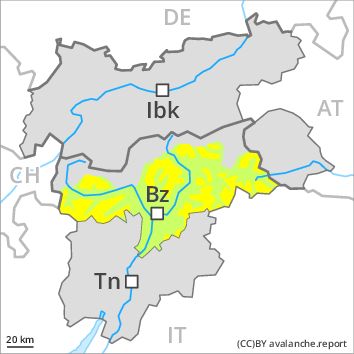Regions
Gröden Dolomites, Prags Dolomites, Sarntal Alps, Western Pfunderer Mountains, Sexten Dolomites, Eastern Pfunderer Mountains, Western Deferegger Alps, Ortler Range, Ulten Valley, Eastern Nonsberger Alps, Northern Dolomites of Fiemme, Saldurn-Mastaun Ridge

Danger level
Danger Level 2 - Moderate above 2200m
Danger Level 1 - Low above 2200m
Avalanche Problem
Persistent weak layer above 2200m, N-NE-E-NW
Wind-drifted snow above 2200m, N-NE-E-SE-S-NW

Wind slabs above the tree line.
Stormy weather. Clearly visible wind slabs will form. The fresh wind slabs are to be avoided in particular in terrain where there is a danger of falling. Single backcountry tourers can release avalanches easily. In many cases they are rather small but in some cases easily released. Additionally in isolated cases dry avalanches can be released in the old snowpack and reach quite a large size. They can be released in particular at transitions from a shallow to a deep snowpack. This also applies adjacent to ridgelines.
Snowpack
The snowpack will be subject to considerable local variations over a wide area. The various wind slabs have bonded quite well together. They are to be found in particular adjacent to ridgelines and in gullies and bowls and at high altitudes. In little used backcountry terrain the avalanche situation is a little more dangerous.
Tendency
The avalanche danger will persist. The weather will be mostly sunny.
Regions
Texel Mountains, Durreck Range, Western Rieserferner Mountains, Val Müstair Alps, Langtaufers, Schnals Ridge, Southern Stubai Alps, Southern Zillertal Alps and High Tauern

Danger level
Danger Level 2 - Moderate above the treeline
Danger Level 1 - Low above the treeline
Avalanche Problem
Wind-drifted snow above the treeline, N-NE-E-SE-S-SW-W-NW
Persistent weak layer above 2200m, N-NE-E-SE-W-NW

Wind slabs above the tree line.
Stormy weather. The fresh wind slabs represent the main danger. Single backcountry tourers can release avalanches easily. In many cases they are rather small but in some cases easily released. The older wind slabs can still be released. Caution is to be exercised at their margins in particular. Avalanches can be released in deep layers in particular at transitions from a shallow to a deep snowpack. This also applies adjacent to ridgelines.
Snowpack
The snowpack will be subject to considerable local variations over a wide area. The fresh snow and wind slabs can be released easily. The various wind slabs of last week can be released in isolated cases, but mostly only by large additional loads,. They are to be found in particular adjacent to ridgelines and in gullies and bowls and at high altitudes. In little used backcountry terrain the avalanche situation is a little more dangerous. Weak layers in the old snowpack are difficult to recognise.
Tendency
The avalanche danger will persist. The weather will be mostly sunny.


